EIA and Soft Tools: A Study on Environmental Impact Assessment and Strategies for Reducing Plastic Waste
VerifiedAdded on 2023/02/01
|14
|3656
|90
AI Summary
This document discusses the concept of Environmental Impact Assessment (EIA) and its importance in assessing the impact of development projects on the environment. It also explores strategies for reducing plastic waste and the role of soft tools in achieving this goal. The document highlights the significance of public participation in EIA and compares the EIA process in Queensland and Western Australia. Course code: N/A, Course name: N/A, College/University: N/A
Contribute Materials
Your contribution can guide someone’s learning journey. Share your
documents today.
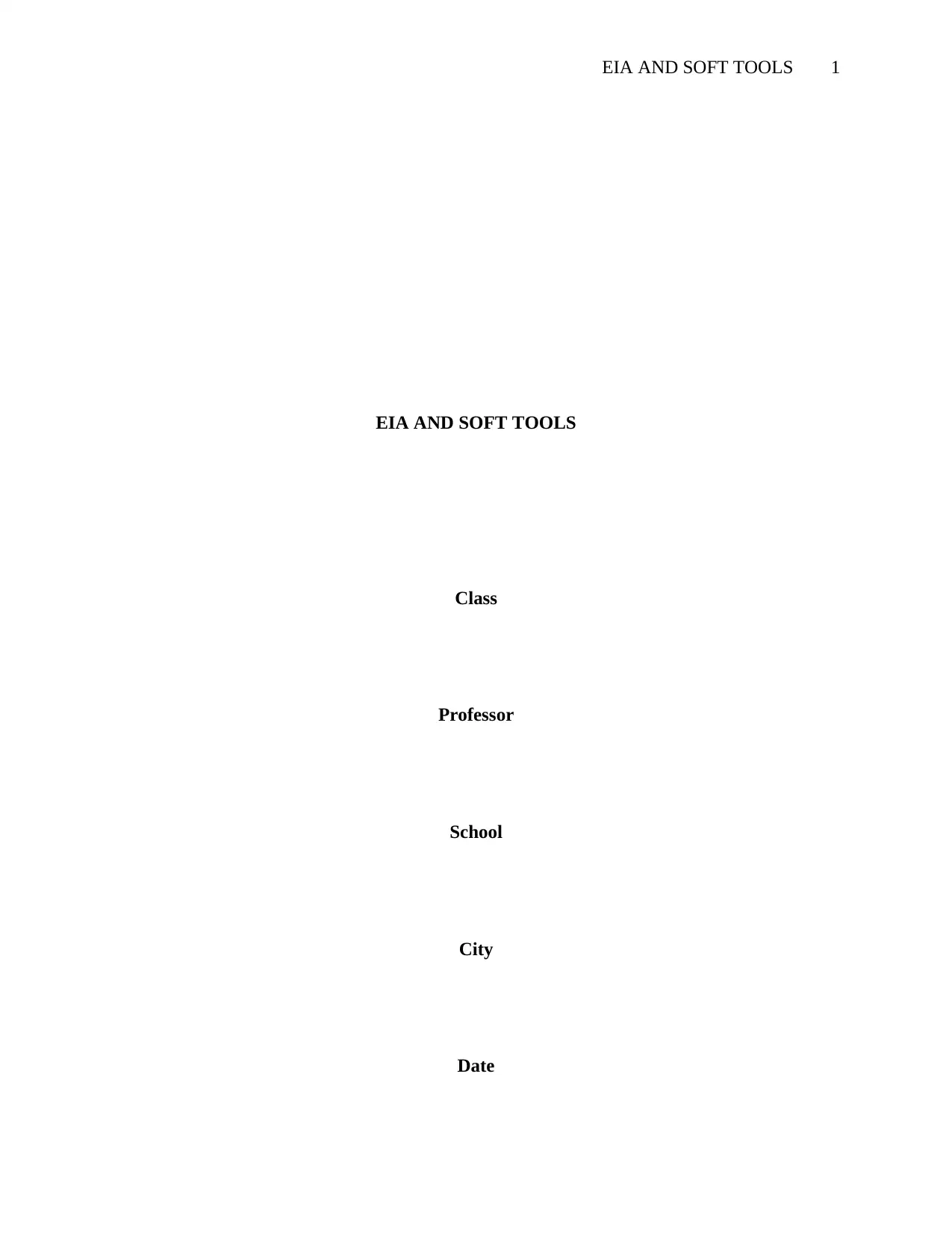
EIA AND SOFT TOOLS 1
EIA AND SOFT TOOLS
Class
Professor
School
City
Date
EIA AND SOFT TOOLS
Class
Professor
School
City
Date
Secure Best Marks with AI Grader
Need help grading? Try our AI Grader for instant feedback on your assignments.
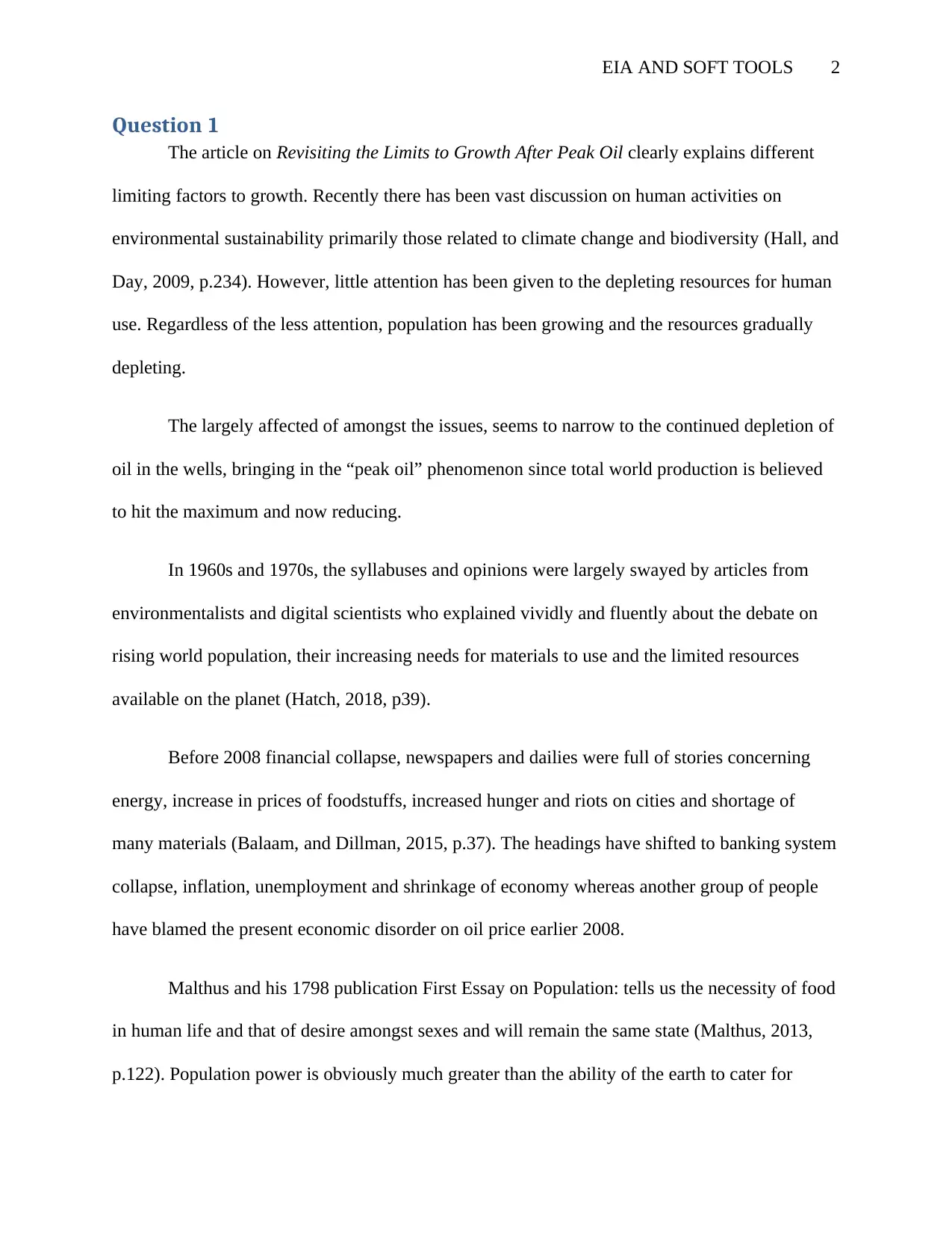
EIA AND SOFT TOOLS 2
Question 1
The article on Revisiting the Limits to Growth After Peak Oil clearly explains different
limiting factors to growth. Recently there has been vast discussion on human activities on
environmental sustainability primarily those related to climate change and biodiversity (Hall, and
Day, 2009, p.234). However, little attention has been given to the depleting resources for human
use. Regardless of the less attention, population has been growing and the resources gradually
depleting.
The largely affected of amongst the issues, seems to narrow to the continued depletion of
oil in the wells, bringing in the “peak oil” phenomenon since total world production is believed
to hit the maximum and now reducing.
In 1960s and 1970s, the syllabuses and opinions were largely swayed by articles from
environmentalists and digital scientists who explained vividly and fluently about the debate on
rising world population, their increasing needs for materials to use and the limited resources
available on the planet (Hatch, 2018, p39).
Before 2008 financial collapse, newspapers and dailies were full of stories concerning
energy, increase in prices of foodstuffs, increased hunger and riots on cities and shortage of
many materials (Balaam, and Dillman, 2015, p.37). The headings have shifted to banking system
collapse, inflation, unemployment and shrinkage of economy whereas another group of people
have blamed the present economic disorder on oil price earlier 2008.
Malthus and his 1798 publication First Essay on Population: tells us the necessity of food
in human life and that of desire amongst sexes and will remain the same state (Malthus, 2013,
p.122). Population power is obviously much greater than the ability of the earth to cater for
Question 1
The article on Revisiting the Limits to Growth After Peak Oil clearly explains different
limiting factors to growth. Recently there has been vast discussion on human activities on
environmental sustainability primarily those related to climate change and biodiversity (Hall, and
Day, 2009, p.234). However, little attention has been given to the depleting resources for human
use. Regardless of the less attention, population has been growing and the resources gradually
depleting.
The largely affected of amongst the issues, seems to narrow to the continued depletion of
oil in the wells, bringing in the “peak oil” phenomenon since total world production is believed
to hit the maximum and now reducing.
In 1960s and 1970s, the syllabuses and opinions were largely swayed by articles from
environmentalists and digital scientists who explained vividly and fluently about the debate on
rising world population, their increasing needs for materials to use and the limited resources
available on the planet (Hatch, 2018, p39).
Before 2008 financial collapse, newspapers and dailies were full of stories concerning
energy, increase in prices of foodstuffs, increased hunger and riots on cities and shortage of
many materials (Balaam, and Dillman, 2015, p.37). The headings have shifted to banking system
collapse, inflation, unemployment and shrinkage of economy whereas another group of people
have blamed the present economic disorder on oil price earlier 2008.
Malthus and his 1798 publication First Essay on Population: tells us the necessity of food
in human life and that of desire amongst sexes and will remain the same state (Malthus, 2013,
p.122). Population power is obviously much greater than the ability of the earth to cater for
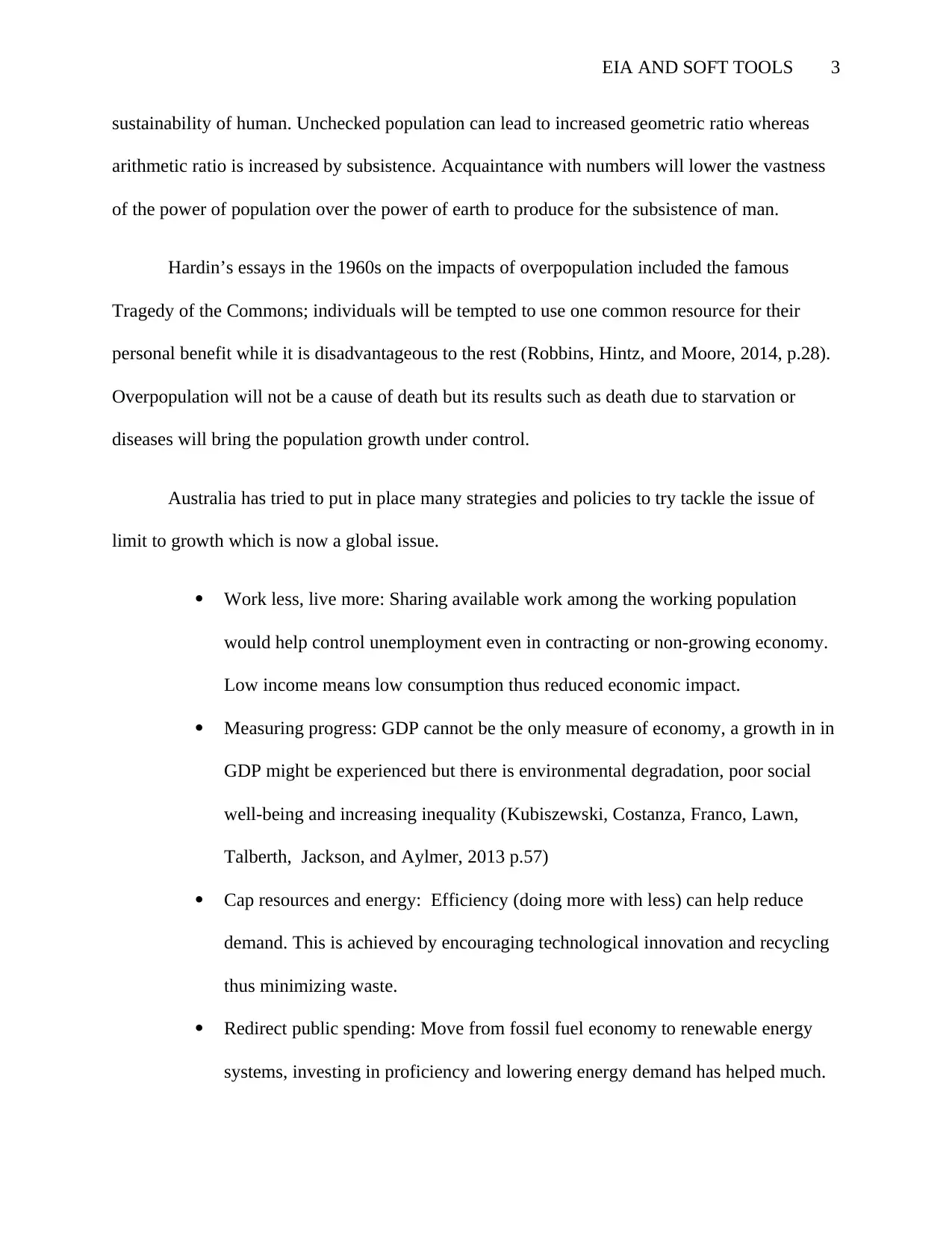
EIA AND SOFT TOOLS 3
sustainability of human. Unchecked population can lead to increased geometric ratio whereas
arithmetic ratio is increased by subsistence. Acquaintance with numbers will lower the vastness
of the power of population over the power of earth to produce for the subsistence of man.
Hardin’s essays in the 1960s on the impacts of overpopulation included the famous
Tragedy of the Commons; individuals will be tempted to use one common resource for their
personal benefit while it is disadvantageous to the rest (Robbins, Hintz, and Moore, 2014, p.28).
Overpopulation will not be a cause of death but its results such as death due to starvation or
diseases will bring the population growth under control.
Australia has tried to put in place many strategies and policies to try tackle the issue of
limit to growth which is now a global issue.
Work less, live more: Sharing available work among the working population
would help control unemployment even in contracting or non-growing economy.
Low income means low consumption thus reduced economic impact.
Measuring progress: GDP cannot be the only measure of economy, a growth in in
GDP might be experienced but there is environmental degradation, poor social
well-being and increasing inequality (Kubiszewski, Costanza, Franco, Lawn,
Talberth, Jackson, and Aylmer, 2013 p.57)
Cap resources and energy: Efficiency (doing more with less) can help reduce
demand. This is achieved by encouraging technological innovation and recycling
thus minimizing waste.
Redirect public spending: Move from fossil fuel economy to renewable energy
systems, investing in proficiency and lowering energy demand has helped much.
sustainability of human. Unchecked population can lead to increased geometric ratio whereas
arithmetic ratio is increased by subsistence. Acquaintance with numbers will lower the vastness
of the power of population over the power of earth to produce for the subsistence of man.
Hardin’s essays in the 1960s on the impacts of overpopulation included the famous
Tragedy of the Commons; individuals will be tempted to use one common resource for their
personal benefit while it is disadvantageous to the rest (Robbins, Hintz, and Moore, 2014, p.28).
Overpopulation will not be a cause of death but its results such as death due to starvation or
diseases will bring the population growth under control.
Australia has tried to put in place many strategies and policies to try tackle the issue of
limit to growth which is now a global issue.
Work less, live more: Sharing available work among the working population
would help control unemployment even in contracting or non-growing economy.
Low income means low consumption thus reduced economic impact.
Measuring progress: GDP cannot be the only measure of economy, a growth in in
GDP might be experienced but there is environmental degradation, poor social
well-being and increasing inequality (Kubiszewski, Costanza, Franco, Lawn,
Talberth, Jackson, and Aylmer, 2013 p.57)
Cap resources and energy: Efficiency (doing more with less) can help reduce
demand. This is achieved by encouraging technological innovation and recycling
thus minimizing waste.
Redirect public spending: Move from fossil fuel economy to renewable energy
systems, investing in proficiency and lowering energy demand has helped much.
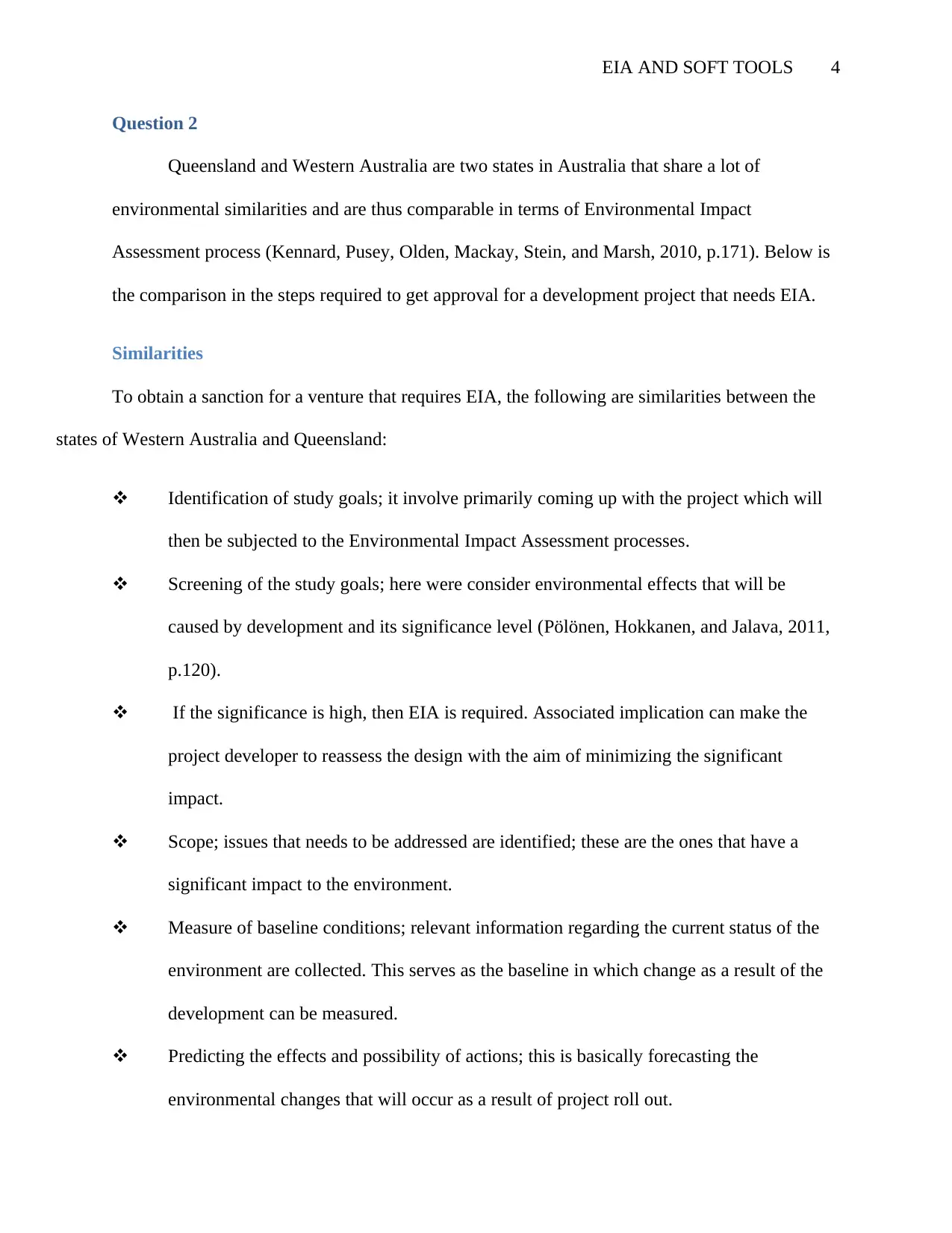
EIA AND SOFT TOOLS 4
Question 2
Queensland and Western Australia are two states in Australia that share a lot of
environmental similarities and are thus comparable in terms of Environmental Impact
Assessment process (Kennard, Pusey, Olden, Mackay, Stein, and Marsh, 2010, p.171). Below is
the comparison in the steps required to get approval for a development project that needs EIA.
Similarities
To obtain a sanction for a venture that requires EIA, the following are similarities between the
states of Western Australia and Queensland:
Identification of study goals; it involve primarily coming up with the project which will
then be subjected to the Environmental Impact Assessment processes.
Screening of the study goals; here were consider environmental effects that will be
caused by development and its significance level (Pölönen, Hokkanen, and Jalava, 2011,
p.120).
If the significance is high, then EIA is required. Associated implication can make the
project developer to reassess the design with the aim of minimizing the significant
impact.
Scope; issues that needs to be addressed are identified; these are the ones that have a
significant impact to the environment.
Measure of baseline conditions; relevant information regarding the current status of the
environment are collected. This serves as the baseline in which change as a result of the
development can be measured.
Predicting the effects and possibility of actions; this is basically forecasting the
environmental changes that will occur as a result of project roll out.
Question 2
Queensland and Western Australia are two states in Australia that share a lot of
environmental similarities and are thus comparable in terms of Environmental Impact
Assessment process (Kennard, Pusey, Olden, Mackay, Stein, and Marsh, 2010, p.171). Below is
the comparison in the steps required to get approval for a development project that needs EIA.
Similarities
To obtain a sanction for a venture that requires EIA, the following are similarities between the
states of Western Australia and Queensland:
Identification of study goals; it involve primarily coming up with the project which will
then be subjected to the Environmental Impact Assessment processes.
Screening of the study goals; here were consider environmental effects that will be
caused by development and its significance level (Pölönen, Hokkanen, and Jalava, 2011,
p.120).
If the significance is high, then EIA is required. Associated implication can make the
project developer to reassess the design with the aim of minimizing the significant
impact.
Scope; issues that needs to be addressed are identified; these are the ones that have a
significant impact to the environment.
Measure of baseline conditions; relevant information regarding the current status of the
environment are collected. This serves as the baseline in which change as a result of the
development can be measured.
Predicting the effects and possibility of actions; this is basically forecasting the
environmental changes that will occur as a result of project roll out.
Secure Best Marks with AI Grader
Need help grading? Try our AI Grader for instant feedback on your assignments.
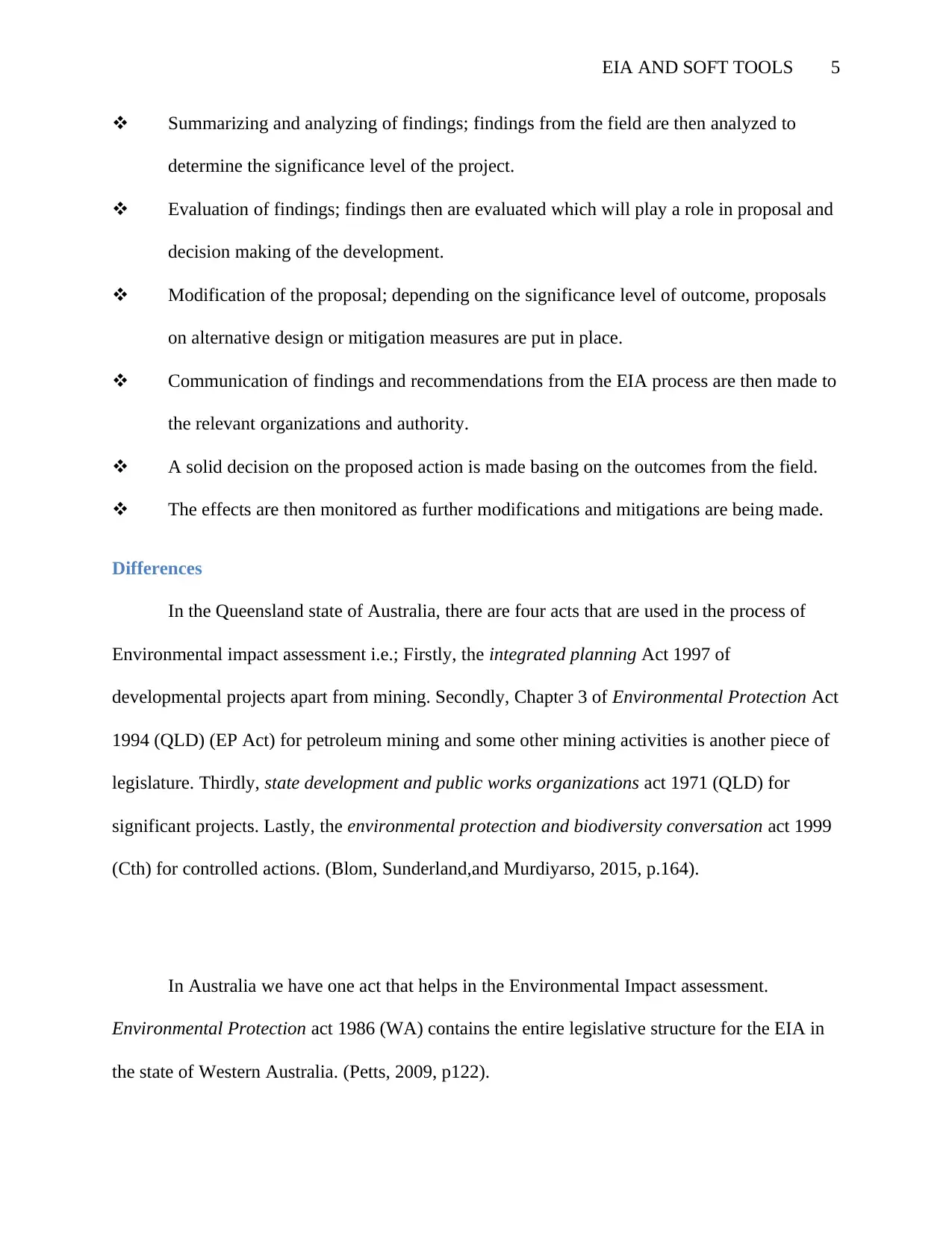
EIA AND SOFT TOOLS 5
Summarizing and analyzing of findings; findings from the field are then analyzed to
determine the significance level of the project.
Evaluation of findings; findings then are evaluated which will play a role in proposal and
decision making of the development.
Modification of the proposal; depending on the significance level of outcome, proposals
on alternative design or mitigation measures are put in place.
Communication of findings and recommendations from the EIA process are then made to
the relevant organizations and authority.
A solid decision on the proposed action is made basing on the outcomes from the field.
The effects are then monitored as further modifications and mitigations are being made.
Differences
In the Queensland state of Australia, there are four acts that are used in the process of
Environmental impact assessment i.e.; Firstly, the integrated planning Act 1997 of
developmental projects apart from mining. Secondly, Chapter 3 of Environmental Protection Act
1994 (QLD) (EP Act) for petroleum mining and some other mining activities is another piece of
legislature. Thirdly, state development and public works organizations act 1971 (QLD) for
significant projects. Lastly, the environmental protection and biodiversity conversation act 1999
(Cth) for controlled actions. (Blom, Sunderland,and Murdiyarso, 2015, p.164).
In Australia we have one act that helps in the Environmental Impact assessment.
Environmental Protection act 1986 (WA) contains the entire legislative structure for the EIA in
the state of Western Australia. (Petts, 2009, p122).
Summarizing and analyzing of findings; findings from the field are then analyzed to
determine the significance level of the project.
Evaluation of findings; findings then are evaluated which will play a role in proposal and
decision making of the development.
Modification of the proposal; depending on the significance level of outcome, proposals
on alternative design or mitigation measures are put in place.
Communication of findings and recommendations from the EIA process are then made to
the relevant organizations and authority.
A solid decision on the proposed action is made basing on the outcomes from the field.
The effects are then monitored as further modifications and mitigations are being made.
Differences
In the Queensland state of Australia, there are four acts that are used in the process of
Environmental impact assessment i.e.; Firstly, the integrated planning Act 1997 of
developmental projects apart from mining. Secondly, Chapter 3 of Environmental Protection Act
1994 (QLD) (EP Act) for petroleum mining and some other mining activities is another piece of
legislature. Thirdly, state development and public works organizations act 1971 (QLD) for
significant projects. Lastly, the environmental protection and biodiversity conversation act 1999
(Cth) for controlled actions. (Blom, Sunderland,and Murdiyarso, 2015, p.164).
In Australia we have one act that helps in the Environmental Impact assessment.
Environmental Protection act 1986 (WA) contains the entire legislative structure for the EIA in
the state of Western Australia. (Petts, 2009, p122).
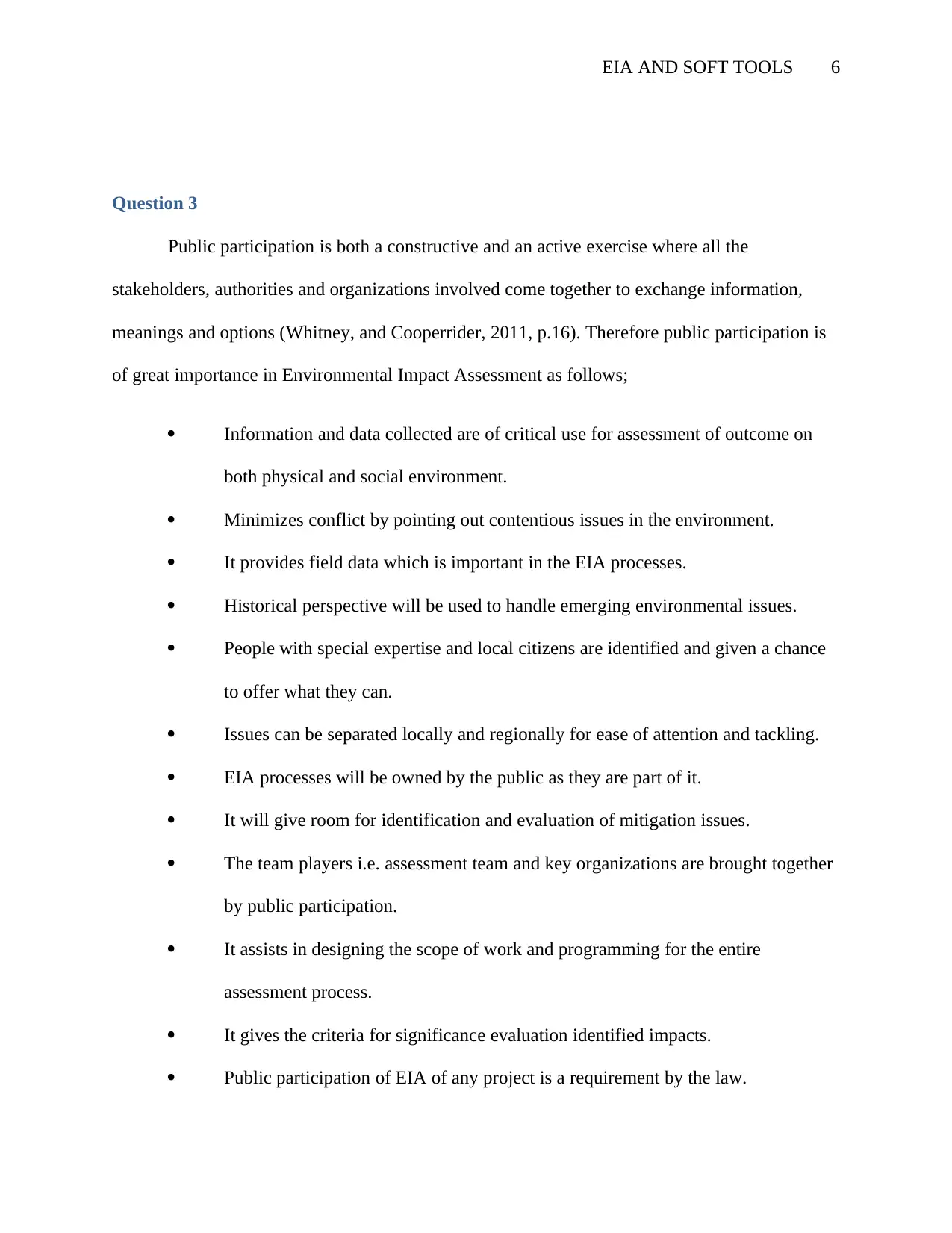
EIA AND SOFT TOOLS 6
Question 3
Public participation is both a constructive and an active exercise where all the
stakeholders, authorities and organizations involved come together to exchange information,
meanings and options (Whitney, and Cooperrider, 2011, p.16). Therefore public participation is
of great importance in Environmental Impact Assessment as follows;
Information and data collected are of critical use for assessment of outcome on
both physical and social environment.
Minimizes conflict by pointing out contentious issues in the environment.
It provides field data which is important in the EIA processes.
Historical perspective will be used to handle emerging environmental issues.
People with special expertise and local citizens are identified and given a chance
to offer what they can.
Issues can be separated locally and regionally for ease of attention and tackling.
EIA processes will be owned by the public as they are part of it.
It will give room for identification and evaluation of mitigation issues.
The team players i.e. assessment team and key organizations are brought together
by public participation.
It assists in designing the scope of work and programming for the entire
assessment process.
It gives the criteria for significance evaluation identified impacts.
Public participation of EIA of any project is a requirement by the law.
Question 3
Public participation is both a constructive and an active exercise where all the
stakeholders, authorities and organizations involved come together to exchange information,
meanings and options (Whitney, and Cooperrider, 2011, p.16). Therefore public participation is
of great importance in Environmental Impact Assessment as follows;
Information and data collected are of critical use for assessment of outcome on
both physical and social environment.
Minimizes conflict by pointing out contentious issues in the environment.
It provides field data which is important in the EIA processes.
Historical perspective will be used to handle emerging environmental issues.
People with special expertise and local citizens are identified and given a chance
to offer what they can.
Issues can be separated locally and regionally for ease of attention and tackling.
EIA processes will be owned by the public as they are part of it.
It will give room for identification and evaluation of mitigation issues.
The team players i.e. assessment team and key organizations are brought together
by public participation.
It assists in designing the scope of work and programming for the entire
assessment process.
It gives the criteria for significance evaluation identified impacts.
Public participation of EIA of any project is a requirement by the law.
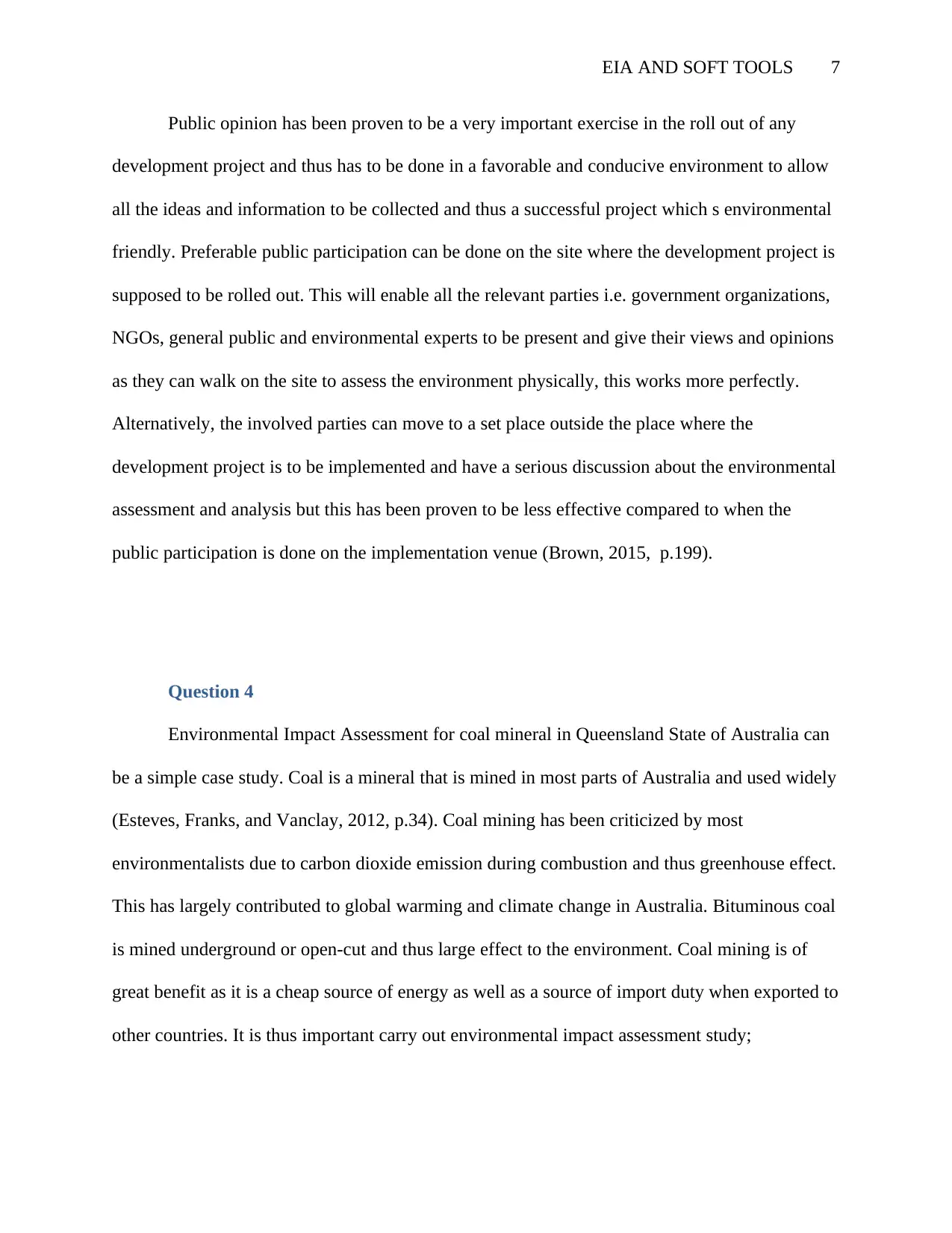
EIA AND SOFT TOOLS 7
Public opinion has been proven to be a very important exercise in the roll out of any
development project and thus has to be done in a favorable and conducive environment to allow
all the ideas and information to be collected and thus a successful project which s environmental
friendly. Preferable public participation can be done on the site where the development project is
supposed to be rolled out. This will enable all the relevant parties i.e. government organizations,
NGOs, general public and environmental experts to be present and give their views and opinions
as they can walk on the site to assess the environment physically, this works more perfectly.
Alternatively, the involved parties can move to a set place outside the place where the
development project is to be implemented and have a serious discussion about the environmental
assessment and analysis but this has been proven to be less effective compared to when the
public participation is done on the implementation venue (Brown, 2015, p.199).
Question 4
Environmental Impact Assessment for coal mineral in Queensland State of Australia can
be a simple case study. Coal is a mineral that is mined in most parts of Australia and used widely
(Esteves, Franks, and Vanclay, 2012, p.34). Coal mining has been criticized by most
environmentalists due to carbon dioxide emission during combustion and thus greenhouse effect.
This has largely contributed to global warming and climate change in Australia. Bituminous coal
is mined underground or open-cut and thus large effect to the environment. Coal mining is of
great benefit as it is a cheap source of energy as well as a source of import duty when exported to
other countries. It is thus important carry out environmental impact assessment study;
Public opinion has been proven to be a very important exercise in the roll out of any
development project and thus has to be done in a favorable and conducive environment to allow
all the ideas and information to be collected and thus a successful project which s environmental
friendly. Preferable public participation can be done on the site where the development project is
supposed to be rolled out. This will enable all the relevant parties i.e. government organizations,
NGOs, general public and environmental experts to be present and give their views and opinions
as they can walk on the site to assess the environment physically, this works more perfectly.
Alternatively, the involved parties can move to a set place outside the place where the
development project is to be implemented and have a serious discussion about the environmental
assessment and analysis but this has been proven to be less effective compared to when the
public participation is done on the implementation venue (Brown, 2015, p.199).
Question 4
Environmental Impact Assessment for coal mineral in Queensland State of Australia can
be a simple case study. Coal is a mineral that is mined in most parts of Australia and used widely
(Esteves, Franks, and Vanclay, 2012, p.34). Coal mining has been criticized by most
environmentalists due to carbon dioxide emission during combustion and thus greenhouse effect.
This has largely contributed to global warming and climate change in Australia. Bituminous coal
is mined underground or open-cut and thus large effect to the environment. Coal mining is of
great benefit as it is a cheap source of energy as well as a source of import duty when exported to
other countries. It is thus important carry out environmental impact assessment study;
Paraphrase This Document
Need a fresh take? Get an instant paraphrase of this document with our AI Paraphraser
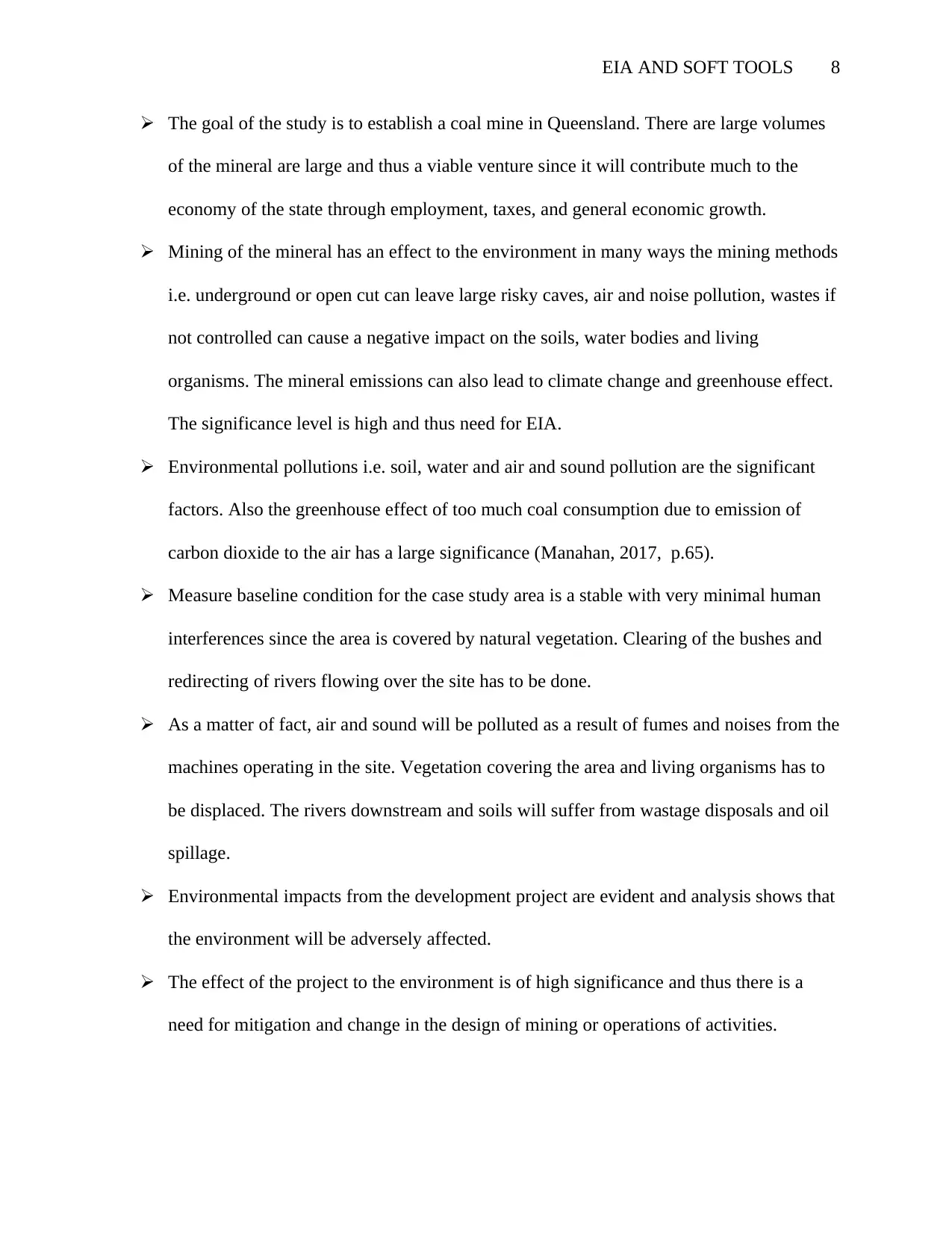
EIA AND SOFT TOOLS 8
The goal of the study is to establish a coal mine in Queensland. There are large volumes
of the mineral are large and thus a viable venture since it will contribute much to the
economy of the state through employment, taxes, and general economic growth.
Mining of the mineral has an effect to the environment in many ways the mining methods
i.e. underground or open cut can leave large risky caves, air and noise pollution, wastes if
not controlled can cause a negative impact on the soils, water bodies and living
organisms. The mineral emissions can also lead to climate change and greenhouse effect.
The significance level is high and thus need for EIA.
Environmental pollutions i.e. soil, water and air and sound pollution are the significant
factors. Also the greenhouse effect of too much coal consumption due to emission of
carbon dioxide to the air has a large significance (Manahan, 2017, p.65).
Measure baseline condition for the case study area is a stable with very minimal human
interferences since the area is covered by natural vegetation. Clearing of the bushes and
redirecting of rivers flowing over the site has to be done.
As a matter of fact, air and sound will be polluted as a result of fumes and noises from the
machines operating in the site. Vegetation covering the area and living organisms has to
be displaced. The rivers downstream and soils will suffer from wastage disposals and oil
spillage.
Environmental impacts from the development project are evident and analysis shows that
the environment will be adversely affected.
The effect of the project to the environment is of high significance and thus there is a
need for mitigation and change in the design of mining or operations of activities.
The goal of the study is to establish a coal mine in Queensland. There are large volumes
of the mineral are large and thus a viable venture since it will contribute much to the
economy of the state through employment, taxes, and general economic growth.
Mining of the mineral has an effect to the environment in many ways the mining methods
i.e. underground or open cut can leave large risky caves, air and noise pollution, wastes if
not controlled can cause a negative impact on the soils, water bodies and living
organisms. The mineral emissions can also lead to climate change and greenhouse effect.
The significance level is high and thus need for EIA.
Environmental pollutions i.e. soil, water and air and sound pollution are the significant
factors. Also the greenhouse effect of too much coal consumption due to emission of
carbon dioxide to the air has a large significance (Manahan, 2017, p.65).
Measure baseline condition for the case study area is a stable with very minimal human
interferences since the area is covered by natural vegetation. Clearing of the bushes and
redirecting of rivers flowing over the site has to be done.
As a matter of fact, air and sound will be polluted as a result of fumes and noises from the
machines operating in the site. Vegetation covering the area and living organisms has to
be displaced. The rivers downstream and soils will suffer from wastage disposals and oil
spillage.
Environmental impacts from the development project are evident and analysis shows that
the environment will be adversely affected.
The effect of the project to the environment is of high significance and thus there is a
need for mitigation and change in the design of mining or operations of activities.
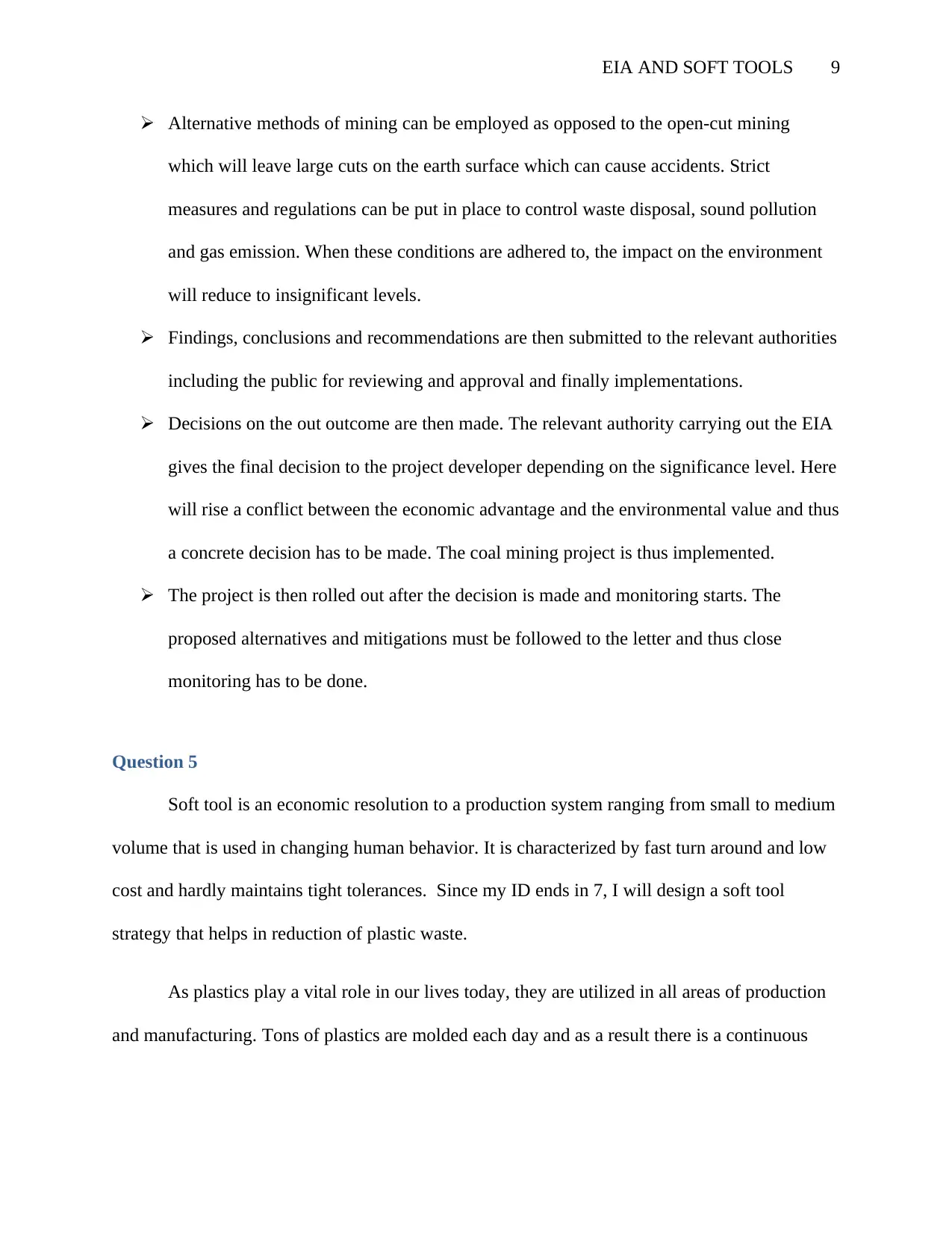
EIA AND SOFT TOOLS 9
Alternative methods of mining can be employed as opposed to the open-cut mining
which will leave large cuts on the earth surface which can cause accidents. Strict
measures and regulations can be put in place to control waste disposal, sound pollution
and gas emission. When these conditions are adhered to, the impact on the environment
will reduce to insignificant levels.
Findings, conclusions and recommendations are then submitted to the relevant authorities
including the public for reviewing and approval and finally implementations.
Decisions on the out outcome are then made. The relevant authority carrying out the EIA
gives the final decision to the project developer depending on the significance level. Here
will rise a conflict between the economic advantage and the environmental value and thus
a concrete decision has to be made. The coal mining project is thus implemented.
The project is then rolled out after the decision is made and monitoring starts. The
proposed alternatives and mitigations must be followed to the letter and thus close
monitoring has to be done.
Question 5
Soft tool is an economic resolution to a production system ranging from small to medium
volume that is used in changing human behavior. It is characterized by fast turn around and low
cost and hardly maintains tight tolerances. Since my ID ends in 7, I will design a soft tool
strategy that helps in reduction of plastic waste.
As plastics play a vital role in our lives today, they are utilized in all areas of production
and manufacturing. Tons of plastics are molded each day and as a result there is a continuous
Alternative methods of mining can be employed as opposed to the open-cut mining
which will leave large cuts on the earth surface which can cause accidents. Strict
measures and regulations can be put in place to control waste disposal, sound pollution
and gas emission. When these conditions are adhered to, the impact on the environment
will reduce to insignificant levels.
Findings, conclusions and recommendations are then submitted to the relevant authorities
including the public for reviewing and approval and finally implementations.
Decisions on the out outcome are then made. The relevant authority carrying out the EIA
gives the final decision to the project developer depending on the significance level. Here
will rise a conflict between the economic advantage and the environmental value and thus
a concrete decision has to be made. The coal mining project is thus implemented.
The project is then rolled out after the decision is made and monitoring starts. The
proposed alternatives and mitigations must be followed to the letter and thus close
monitoring has to be done.
Question 5
Soft tool is an economic resolution to a production system ranging from small to medium
volume that is used in changing human behavior. It is characterized by fast turn around and low
cost and hardly maintains tight tolerances. Since my ID ends in 7, I will design a soft tool
strategy that helps in reduction of plastic waste.
As plastics play a vital role in our lives today, they are utilized in all areas of production
and manufacturing. Tons of plastics are molded each day and as a result there is a continuous
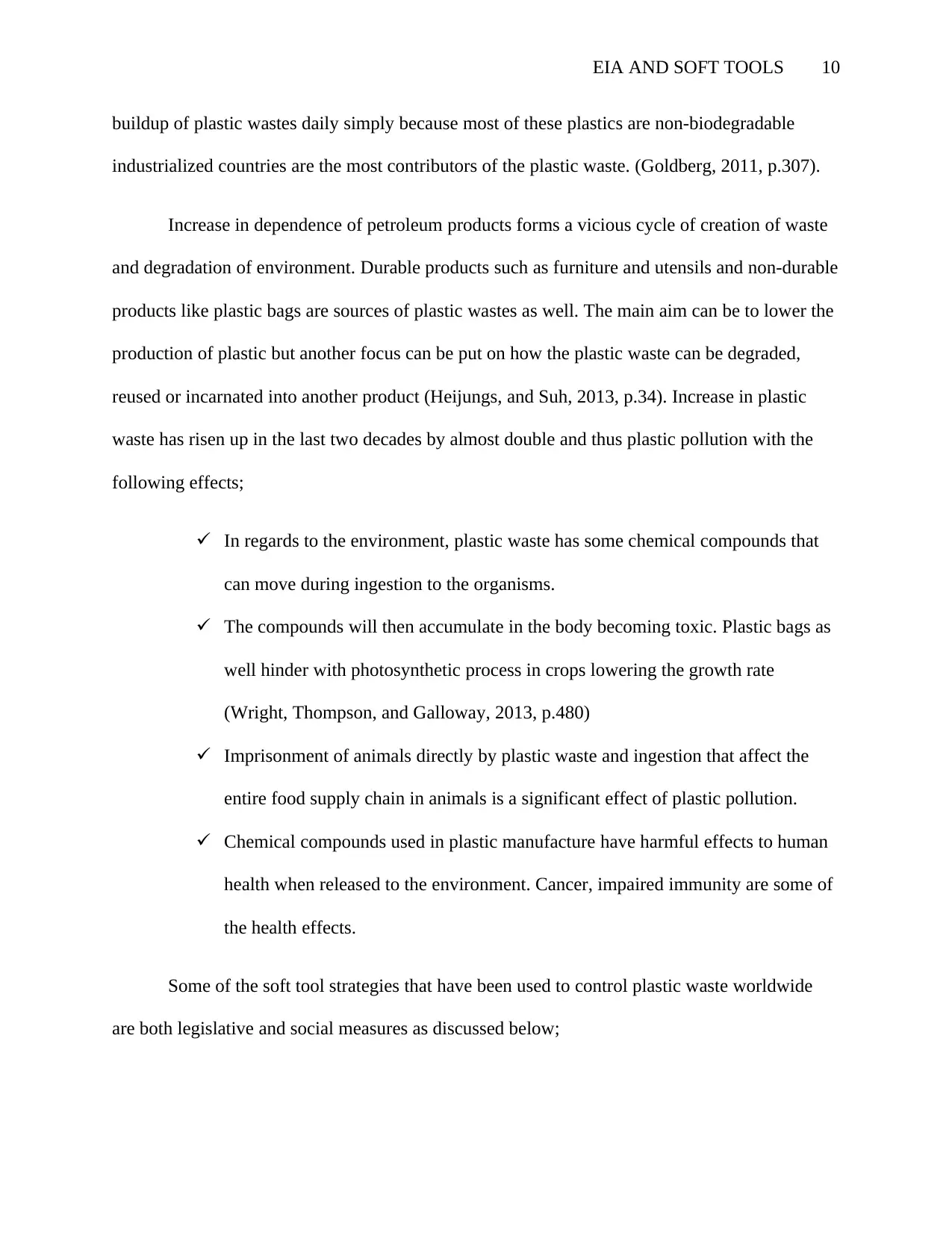
EIA AND SOFT TOOLS 10
buildup of plastic wastes daily simply because most of these plastics are non-biodegradable
industrialized countries are the most contributors of the plastic waste. (Goldberg, 2011, p.307).
Increase in dependence of petroleum products forms a vicious cycle of creation of waste
and degradation of environment. Durable products such as furniture and utensils and non-durable
products like plastic bags are sources of plastic wastes as well. The main aim can be to lower the
production of plastic but another focus can be put on how the plastic waste can be degraded,
reused or incarnated into another product (Heijungs, and Suh, 2013, p.34). Increase in plastic
waste has risen up in the last two decades by almost double and thus plastic pollution with the
following effects;
In regards to the environment, plastic waste has some chemical compounds that
can move during ingestion to the organisms.
The compounds will then accumulate in the body becoming toxic. Plastic bags as
well hinder with photosynthetic process in crops lowering the growth rate
(Wright, Thompson, and Galloway, 2013, p.480)
Imprisonment of animals directly by plastic waste and ingestion that affect the
entire food supply chain in animals is a significant effect of plastic pollution.
Chemical compounds used in plastic manufacture have harmful effects to human
health when released to the environment. Cancer, impaired immunity are some of
the health effects.
Some of the soft tool strategies that have been used to control plastic waste worldwide
are both legislative and social measures as discussed below;
buildup of plastic wastes daily simply because most of these plastics are non-biodegradable
industrialized countries are the most contributors of the plastic waste. (Goldberg, 2011, p.307).
Increase in dependence of petroleum products forms a vicious cycle of creation of waste
and degradation of environment. Durable products such as furniture and utensils and non-durable
products like plastic bags are sources of plastic wastes as well. The main aim can be to lower the
production of plastic but another focus can be put on how the plastic waste can be degraded,
reused or incarnated into another product (Heijungs, and Suh, 2013, p.34). Increase in plastic
waste has risen up in the last two decades by almost double and thus plastic pollution with the
following effects;
In regards to the environment, plastic waste has some chemical compounds that
can move during ingestion to the organisms.
The compounds will then accumulate in the body becoming toxic. Plastic bags as
well hinder with photosynthetic process in crops lowering the growth rate
(Wright, Thompson, and Galloway, 2013, p.480)
Imprisonment of animals directly by plastic waste and ingestion that affect the
entire food supply chain in animals is a significant effect of plastic pollution.
Chemical compounds used in plastic manufacture have harmful effects to human
health when released to the environment. Cancer, impaired immunity are some of
the health effects.
Some of the soft tool strategies that have been used to control plastic waste worldwide
are both legislative and social measures as discussed below;
Secure Best Marks with AI Grader
Need help grading? Try our AI Grader for instant feedback on your assignments.
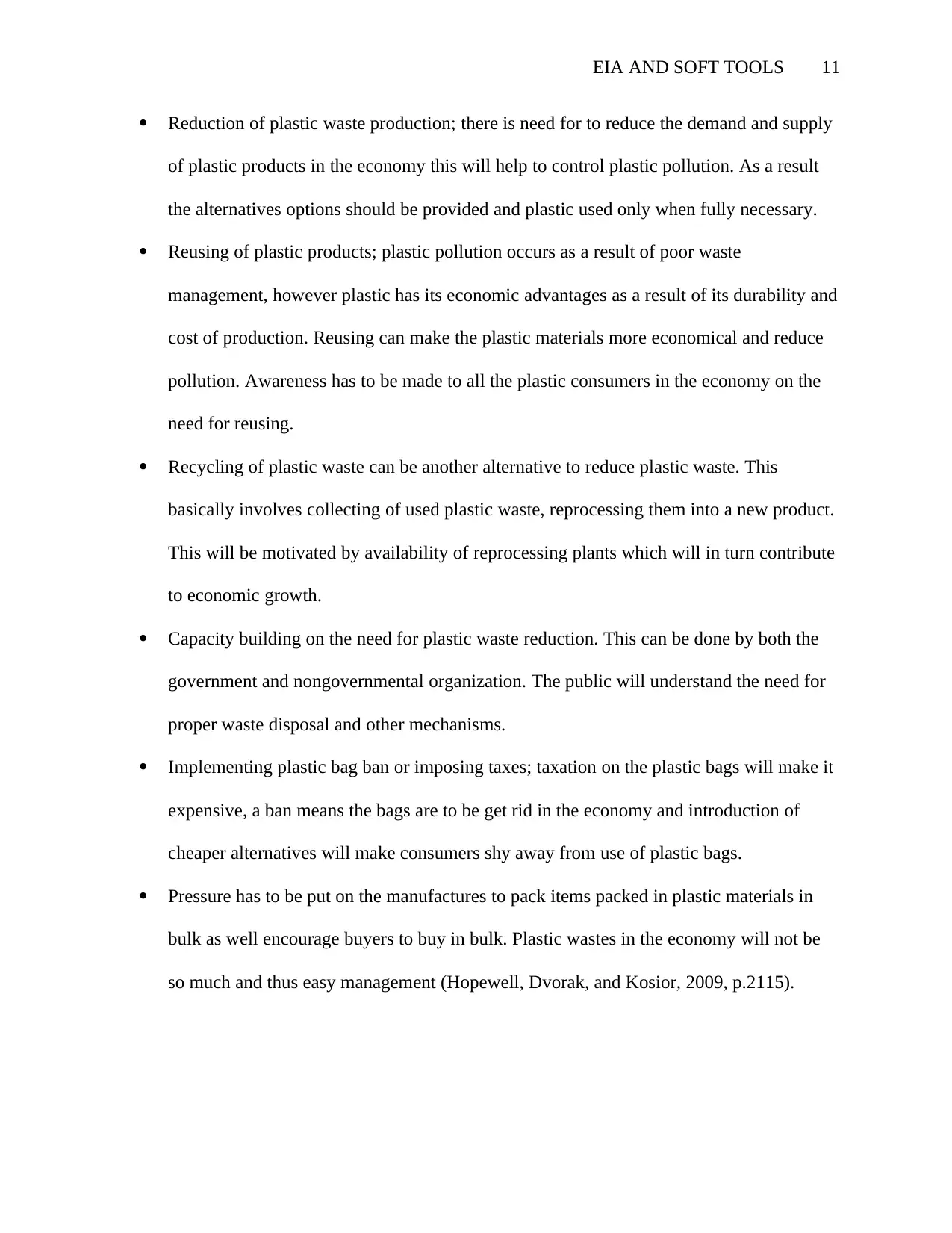
EIA AND SOFT TOOLS 11
Reduction of plastic waste production; there is need for to reduce the demand and supply
of plastic products in the economy this will help to control plastic pollution. As a result
the alternatives options should be provided and plastic used only when fully necessary.
Reusing of plastic products; plastic pollution occurs as a result of poor waste
management, however plastic has its economic advantages as a result of its durability and
cost of production. Reusing can make the plastic materials more economical and reduce
pollution. Awareness has to be made to all the plastic consumers in the economy on the
need for reusing.
Recycling of plastic waste can be another alternative to reduce plastic waste. This
basically involves collecting of used plastic waste, reprocessing them into a new product.
This will be motivated by availability of reprocessing plants which will in turn contribute
to economic growth.
Capacity building on the need for plastic waste reduction. This can be done by both the
government and nongovernmental organization. The public will understand the need for
proper waste disposal and other mechanisms.
Implementing plastic bag ban or imposing taxes; taxation on the plastic bags will make it
expensive, a ban means the bags are to be get rid in the economy and introduction of
cheaper alternatives will make consumers shy away from use of plastic bags.
Pressure has to be put on the manufactures to pack items packed in plastic materials in
bulk as well encourage buyers to buy in bulk. Plastic wastes in the economy will not be
so much and thus easy management (Hopewell, Dvorak, and Kosior, 2009, p.2115).
Reduction of plastic waste production; there is need for to reduce the demand and supply
of plastic products in the economy this will help to control plastic pollution. As a result
the alternatives options should be provided and plastic used only when fully necessary.
Reusing of plastic products; plastic pollution occurs as a result of poor waste
management, however plastic has its economic advantages as a result of its durability and
cost of production. Reusing can make the plastic materials more economical and reduce
pollution. Awareness has to be made to all the plastic consumers in the economy on the
need for reusing.
Recycling of plastic waste can be another alternative to reduce plastic waste. This
basically involves collecting of used plastic waste, reprocessing them into a new product.
This will be motivated by availability of reprocessing plants which will in turn contribute
to economic growth.
Capacity building on the need for plastic waste reduction. This can be done by both the
government and nongovernmental organization. The public will understand the need for
proper waste disposal and other mechanisms.
Implementing plastic bag ban or imposing taxes; taxation on the plastic bags will make it
expensive, a ban means the bags are to be get rid in the economy and introduction of
cheaper alternatives will make consumers shy away from use of plastic bags.
Pressure has to be put on the manufactures to pack items packed in plastic materials in
bulk as well encourage buyers to buy in bulk. Plastic wastes in the economy will not be
so much and thus easy management (Hopewell, Dvorak, and Kosior, 2009, p.2115).

EIA AND SOFT TOOLS 12
These strategies have been applied worldwide and have been proved to work and control
the quantity of plastic wastes to a manageable amount in different countries of similar
socioeconomic status to Australia.
These strategies have been applied worldwide and have been proved to work and control
the quantity of plastic wastes to a manageable amount in different countries of similar
socioeconomic status to Australia.
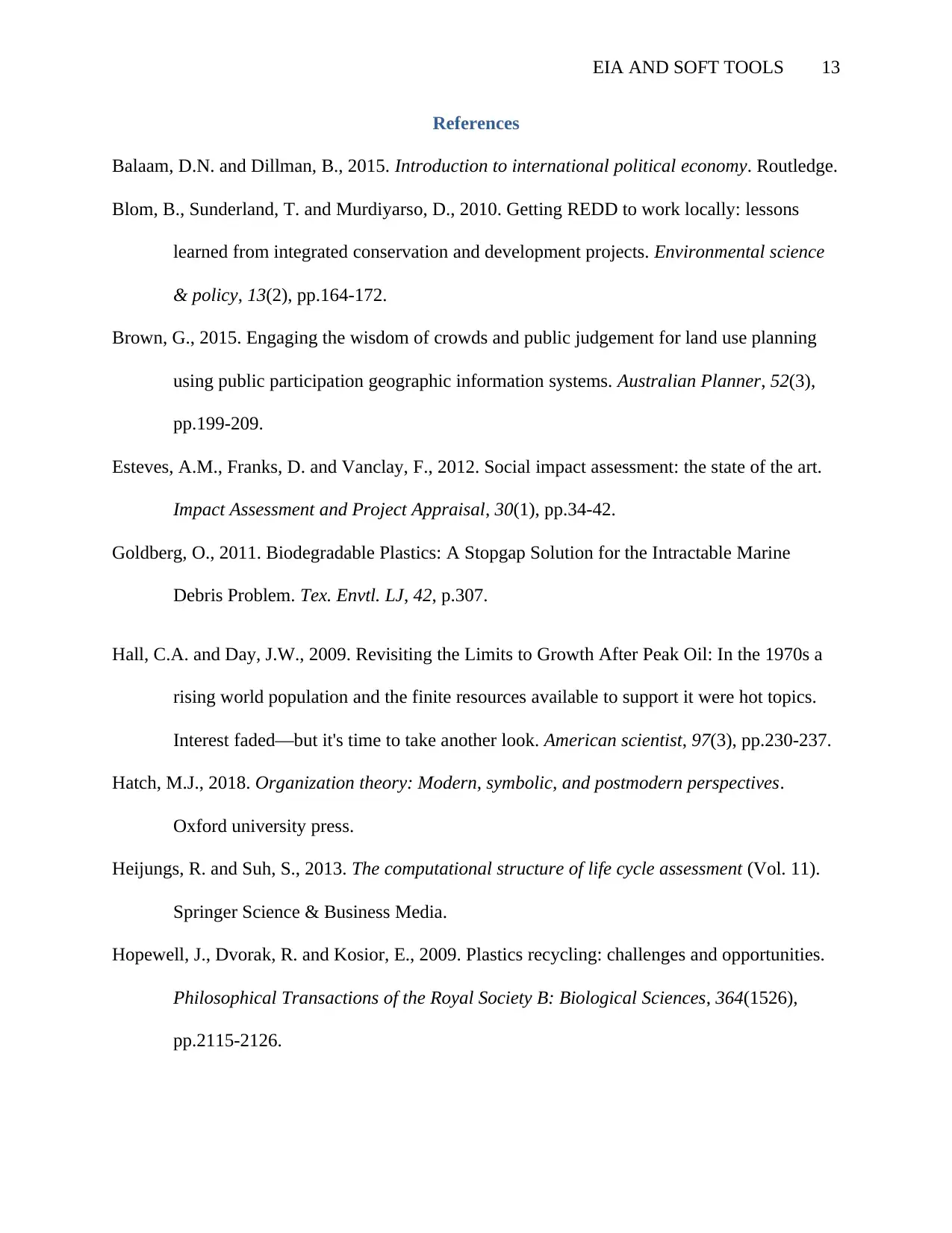
EIA AND SOFT TOOLS 13
References
Balaam, D.N. and Dillman, B., 2015. Introduction to international political economy. Routledge.
Blom, B., Sunderland, T. and Murdiyarso, D., 2010. Getting REDD to work locally: lessons
learned from integrated conservation and development projects. Environmental science
& policy, 13(2), pp.164-172.
Brown, G., 2015. Engaging the wisdom of crowds and public judgement for land use planning
using public participation geographic information systems. Australian Planner, 52(3),
pp.199-209.
Esteves, A.M., Franks, D. and Vanclay, F., 2012. Social impact assessment: the state of the art.
Impact Assessment and Project Appraisal, 30(1), pp.34-42.
Goldberg, O., 2011. Biodegradable Plastics: A Stopgap Solution for the Intractable Marine
Debris Problem. Tex. Envtl. LJ, 42, p.307.
Hall, C.A. and Day, J.W., 2009. Revisiting the Limits to Growth After Peak Oil: In the 1970s a
rising world population and the finite resources available to support it were hot topics.
Interest faded—but it's time to take another look. American scientist, 97(3), pp.230-237.
Hatch, M.J., 2018. Organization theory: Modern, symbolic, and postmodern perspectives.
Oxford university press.
Heijungs, R. and Suh, S., 2013. The computational structure of life cycle assessment (Vol. 11).
Springer Science & Business Media.
Hopewell, J., Dvorak, R. and Kosior, E., 2009. Plastics recycling: challenges and opportunities.
Philosophical Transactions of the Royal Society B: Biological Sciences, 364(1526),
pp.2115-2126.
References
Balaam, D.N. and Dillman, B., 2015. Introduction to international political economy. Routledge.
Blom, B., Sunderland, T. and Murdiyarso, D., 2010. Getting REDD to work locally: lessons
learned from integrated conservation and development projects. Environmental science
& policy, 13(2), pp.164-172.
Brown, G., 2015. Engaging the wisdom of crowds and public judgement for land use planning
using public participation geographic information systems. Australian Planner, 52(3),
pp.199-209.
Esteves, A.M., Franks, D. and Vanclay, F., 2012. Social impact assessment: the state of the art.
Impact Assessment and Project Appraisal, 30(1), pp.34-42.
Goldberg, O., 2011. Biodegradable Plastics: A Stopgap Solution for the Intractable Marine
Debris Problem. Tex. Envtl. LJ, 42, p.307.
Hall, C.A. and Day, J.W., 2009. Revisiting the Limits to Growth After Peak Oil: In the 1970s a
rising world population and the finite resources available to support it were hot topics.
Interest faded—but it's time to take another look. American scientist, 97(3), pp.230-237.
Hatch, M.J., 2018. Organization theory: Modern, symbolic, and postmodern perspectives.
Oxford university press.
Heijungs, R. and Suh, S., 2013. The computational structure of life cycle assessment (Vol. 11).
Springer Science & Business Media.
Hopewell, J., Dvorak, R. and Kosior, E., 2009. Plastics recycling: challenges and opportunities.
Philosophical Transactions of the Royal Society B: Biological Sciences, 364(1526),
pp.2115-2126.
Paraphrase This Document
Need a fresh take? Get an instant paraphrase of this document with our AI Paraphraser
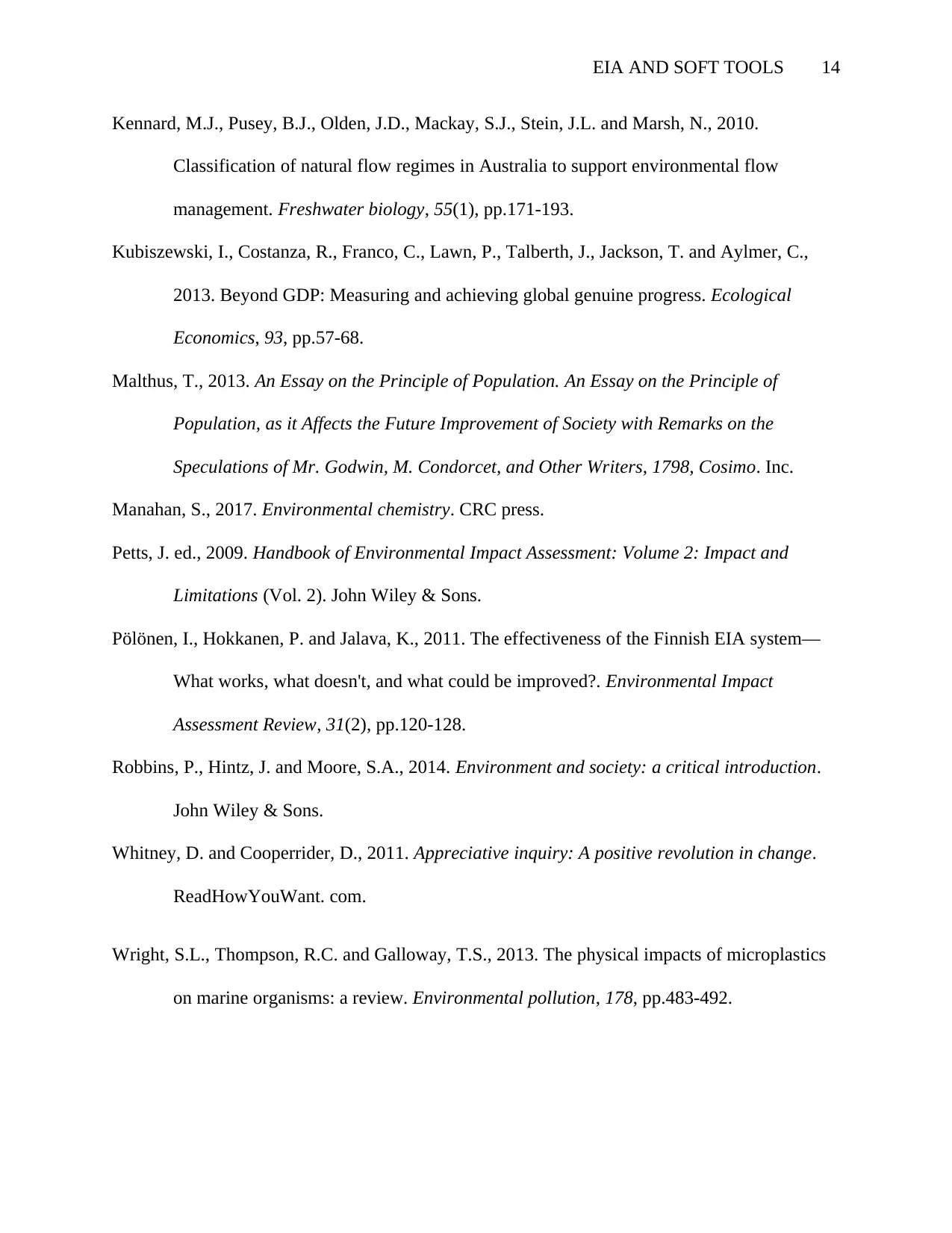
EIA AND SOFT TOOLS 14
Kennard, M.J., Pusey, B.J., Olden, J.D., Mackay, S.J., Stein, J.L. and Marsh, N., 2010.
Classification of natural flow regimes in Australia to support environmental flow
management. Freshwater biology, 55(1), pp.171-193.
Kubiszewski, I., Costanza, R., Franco, C., Lawn, P., Talberth, J., Jackson, T. and Aylmer, C.,
2013. Beyond GDP: Measuring and achieving global genuine progress. Ecological
Economics, 93, pp.57-68.
Malthus, T., 2013. An Essay on the Principle of Population. An Essay on the Principle of
Population, as it Affects the Future Improvement of Society with Remarks on the
Speculations of Mr. Godwin, M. Condorcet, and Other Writers, 1798, Cosimo. Inc.
Manahan, S., 2017. Environmental chemistry. CRC press.
Petts, J. ed., 2009. Handbook of Environmental Impact Assessment: Volume 2: Impact and
Limitations (Vol. 2). John Wiley & Sons.
Pölönen, I., Hokkanen, P. and Jalava, K., 2011. The effectiveness of the Finnish EIA system—
What works, what doesn't, and what could be improved?. Environmental Impact
Assessment Review, 31(2), pp.120-128.
Robbins, P., Hintz, J. and Moore, S.A., 2014. Environment and society: a critical introduction.
John Wiley & Sons.
Whitney, D. and Cooperrider, D., 2011. Appreciative inquiry: A positive revolution in change.
ReadHowYouWant. com.
Wright, S.L., Thompson, R.C. and Galloway, T.S., 2013. The physical impacts of microplastics
on marine organisms: a review. Environmental pollution, 178, pp.483-492.
Kennard, M.J., Pusey, B.J., Olden, J.D., Mackay, S.J., Stein, J.L. and Marsh, N., 2010.
Classification of natural flow regimes in Australia to support environmental flow
management. Freshwater biology, 55(1), pp.171-193.
Kubiszewski, I., Costanza, R., Franco, C., Lawn, P., Talberth, J., Jackson, T. and Aylmer, C.,
2013. Beyond GDP: Measuring and achieving global genuine progress. Ecological
Economics, 93, pp.57-68.
Malthus, T., 2013. An Essay on the Principle of Population. An Essay on the Principle of
Population, as it Affects the Future Improvement of Society with Remarks on the
Speculations of Mr. Godwin, M. Condorcet, and Other Writers, 1798, Cosimo. Inc.
Manahan, S., 2017. Environmental chemistry. CRC press.
Petts, J. ed., 2009. Handbook of Environmental Impact Assessment: Volume 2: Impact and
Limitations (Vol. 2). John Wiley & Sons.
Pölönen, I., Hokkanen, P. and Jalava, K., 2011. The effectiveness of the Finnish EIA system—
What works, what doesn't, and what could be improved?. Environmental Impact
Assessment Review, 31(2), pp.120-128.
Robbins, P., Hintz, J. and Moore, S.A., 2014. Environment and society: a critical introduction.
John Wiley & Sons.
Whitney, D. and Cooperrider, D., 2011. Appreciative inquiry: A positive revolution in change.
ReadHowYouWant. com.
Wright, S.L., Thompson, R.C. and Galloway, T.S., 2013. The physical impacts of microplastics
on marine organisms: a review. Environmental pollution, 178, pp.483-492.
1 out of 14
Related Documents
Your All-in-One AI-Powered Toolkit for Academic Success.
+13062052269
info@desklib.com
Available 24*7 on WhatsApp / Email
![[object Object]](/_next/static/media/star-bottom.7253800d.svg)
Unlock your academic potential
© 2024 | Zucol Services PVT LTD | All rights reserved.





